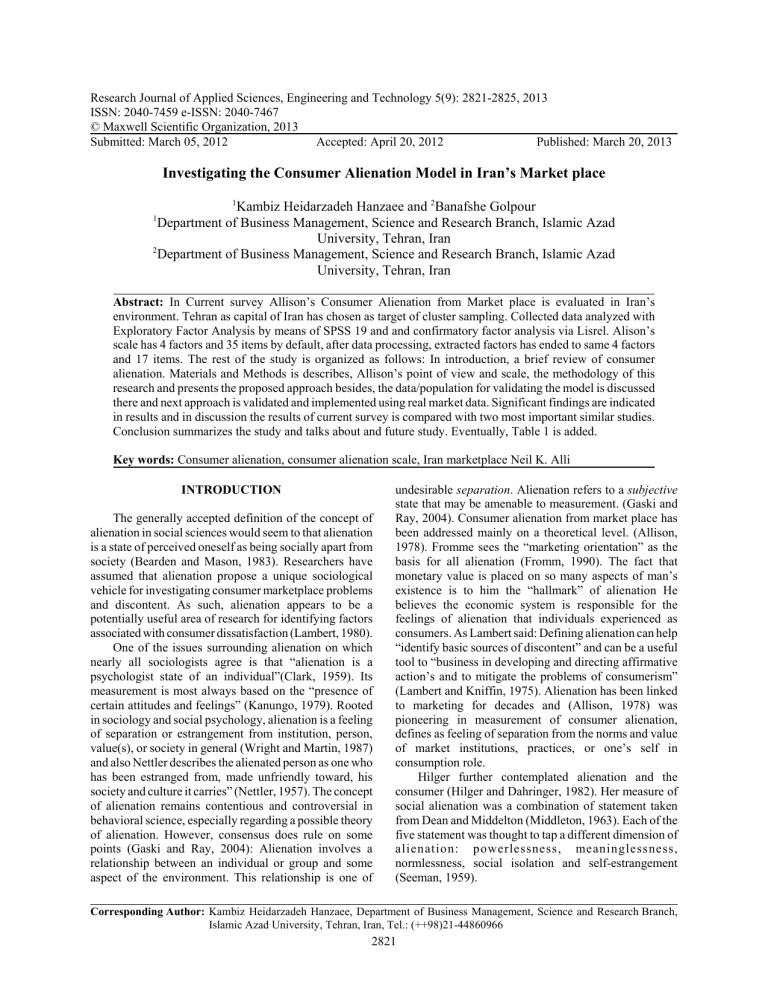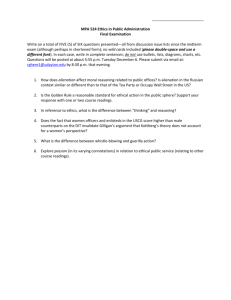Research Journal of Applied Sciences, Engineering and Technology 5(9): 2821-2825,... ISSN: 2040-7459 e-ISSN: 2040-7467

Research Journal of Applied Sciences, Engineering and Technology 5(9): 2821-2825, 2013
ISSN: 2040-7459 e-ISSN: 2040-7467
© Maxwell Scientific Organization, 2013
Submitted: March 05, 2012 Accepted: April 20, 2012 Published: March 20, 2013
Investigating the Consumer Alienation Model in Iran’s Market place
1
Kambiz Heidarzadeh Hanzaee and
2
Banafshe Golpour
1
Department of Business Management, Science and Research Branch, Islamic Azad
University, Tehran, Iran
2
Department of Business Management, Science and Research Branch, Islamic Azad
University, Tehran, Iran
Abstract: In Current survey Allison’s Consumer Alienation from Market place is evaluated in Iran’s environment. Tehran as capital of Iran has chosen as target of cluster sampling. Collected data analyzed with
Exploratory Factor Analysis by means of SPSS 19 and and confirmatory factor analysis via Lisrel. Alison’s scale has 4 factors and 35 items by default, after data processing, extracted factors has ended to same 4 factors and 17 items. The rest of the study is organized as follows: In introduction, a brief review of consumer alienation. Materials and Methods is describes, Allison’s point of view and scale, the methodology of this research and presents the proposed approach besides, the data/population for validating the model is discussed there and next approach is validated and implemented using real market data. Significant findings are indicated in results and in discussion the results of current survey is compared with two most important similar studies.
Conclusion summarizes the study and talks about and future study. Eventually, Table 1 is added.
Key words: Consumer alienation, consumer alienation scale, Iran marketplace Neil K. Alli
INTRODUCTION
The generally accepted definition of the concept of alienation in social sciences would seem to that alienation is a state of perceived oneself as being socially apart from society (Bearden and Mason, 1983). Researchers have assumed that alienation propose a unique sociological vehicle for investigating consumer marketplace problems and discontent. As such, alienation appears to be a potentially useful area of research for identifying factors associated with consumer dissatisfaction (Lambert, 1980).
One of the issues surrounding alienation on which nearly all sociologists agree is that “alienation is a psychologist state of an individual”(Clark, 1959). Its measurement is most always based on the “presence of certain attitudes and feelings” (Kanungo, 1979). Rooted in sociology and social psychology, alienation is a feeling of separation or estrangement from institution, person, value(s), or society in general (Wright and Martin, 1987) and also Nettler describes the alienated person as one who has been estranged from, made unfriendly toward, his society and culture it carries” (Nettler, 1957). The concept of alienation remains contentious and controversial in behavioral science, especially regarding a possible theory of alienation. However, consensus does rule on some points (Gaski and Ray, 2004): Alienation involves a relationship between an individual or group and some aspect of the environment. This relationship is one of undesirable separation . Alienation refers to a subjective state that may be amenable to measurement. (Gaski and
Ray, 2004). Consumer alienation from market place has been addressed mainly on a theoretical level. (Allison,
1978). Fromme sees the “marketing orientation” as the basis for all alienation (Fromm, 1990). The fact that monetary value is placed on so many aspects of man’s existence is to him the “hallmark” of alienation He believes the economic system is responsible for the feelings of alienation that individuals experienced as consumers. As Lambert said: Defining alienation can help
“identify basic sources of discontent” and can be a useful tool to “business in developing and directing affirmative action’s and to mitigate the problems of consumerism”
(Lambert and Kniffin, 1975). Alienation has been linked to marketing for decades and (Allison, 1978) was pioneering in measurement of consumer alienation, defines as feeling of separation from the norms and value of market institutions, practices, or one’s self in consumption role.
Hilger further contemplated alienation and the consumer (Hilger and Dahringer, 1982). Her measure of social alienation was a combination of statement taken from Dean and Middelton (Middleton, 1963). Each of the five statement was thought to tap a different dimension of alienation: powerlessness, meaninglessness, normlessness, social isolation and self-estrangement
(Seeman, 1959).
Corresponding Author: Kambiz Heidarzadeh Hanzaee, Department of Business Management, Science and Research Branch,
Islamic Azad University, Tehran, Iran, Tel.: (++98)21-44860966
2821
Consider current economic situation of the world, especially Middle East and more exclusively Iran societal pathology, certainly large segments of the population who
(Gaski and Ray, 2004).
The aim of this study is to investigate the consumer
Alienation model in current socio-economic situation of
Iran by means of Allison’s scale of alienation.
In order to evaluate consumer alienation model, as
(Allison, 1978) describes-and his scale’s items reflects-the syndrome of alienation was conceptualized initially on the basis constructs of powerlessness, normlessness, meaninglessness and social isolation.
Powerlessness is defined as feelings held by consumers that they are unable to help determine market practices, an inability to control the market environment or events within the marketplace. Normlessness within the market system is represented by a distrust of business and market practices, often manifested in unclear standards for buyers. Social isolation from the market place is characterized by feelings of estrangement from the institutions, practices and outputs of the commodity market system. Feelings of self-estrangement arise from an inability to identify with behavior traditionally associated with the consumption role (Allison, 1978;
Bearden and Mason, 1983). These definitions are based largely on the classical theory of Durkheim (1897),
Seeman (1959), Weber (1968), Marx (1972) and Tannies
(2002).
Allison’s (1978) scale items-which initially was formed from Dean’s (1961) subscales of powerlessness, normlessness, meaninglessness and social isolationappraised using 35 item inventory statements developed and validate by (Allison, 1978). Each statement in the scale was followed by a 5 place Likert scale (5 = strongly agree, 4 = agree, 3 = neutral, 2 = disagree, 1 = strongly disagree). The questionnaire was allocated to 4 sections the consumer alienation measure consisted of Dean’s subscale. Reliability and validity of Dean’s index are reported by (Robinson et al ., 1991; Miller and Salkind,
2002). But in order to reassuring, the internal consistency of measurement instrument accessed via Cronbach’s coefficient alpha, as it shows in Table 1, the result is near
1 and it is a proof of reliability of measurement instrument.
MATERIALS AND METHODS
Reliability statistics: status (Table 2).
Res. J. Appl. Sci. Eng. Technol., 5(9): 2821-2825, 2013
In Allison’s research the demographic variables was included sex, age, marital status, ethnic origin, but in current research because of social reasons we omitted the variable of ethnic origin and the demographic variables include sex, age and marital
Table 1: Extraction method: Principal component analysis
Communalities
------------------------------------------------------------------------------------extraction n2 n3 n4 n5
SE5
SE6
SE7 n1
SI6
SI7
SI8
SE1
SE2
SE3
SE4 p2 p3 p4 p5
SI1
SI2
SI3
SI4
SI5 n6 n7 n8 n9 n10 n11 n12 n13 n14 n15 p1
0.666
0.631
0.670
0.705
0.566
0.703
0.646
0.599
0.675
0.615
0.722
0.603
0.585
0.590
0.573
0.637
0.637
0.628
0.669
0.625
0.567
0.652
0.549
0.688
0.587
0.706
0.623
0.615
0.638
0.636
0.667
0.658
0.679
0.654
0.704
Table 2: Calculated by authors Spps 19
Cronbach's alpha
0.929
N of items
28
Using cluster method, a convenience sample (307 individuals) representative of Iran’s Capital (Tehran) citizens was provided and data collecting and data analyzing was conducted in Fall and Winter of 2011.
The questionnaire was originally designed in English and then translated in to Persian (common language of
Iranians). Translated questionnaire reviewed by 24 marketing experts in order to confirm content validity.
The scale items were chose originally to reflect powerlessness, normlessness; social isolation and self estrangement, factors representing each of these variants of alienation were anticipated to appear. The 35 items were factor analyzed based on quota sample of 307
Iranian individuals. Exploratory Factor Analysis (EFA) which is a complex, multi-step process, was applied to evaluate Consumer alienation in Iran Market place. EFA, traditionally, has been used to explore the possible underlying factor structure of a set of observed variables without imposing a preconceived structure on the
2822
(Table 3). items. (Reise et al ., 2000)
Res. J. Appl. Sci. Eng. Technol., 5(9): 2821-2825, 2013
Table 3: Demographic specifications
Male-female
Single-married
Age
Table 4: Calculated by authors
Kaiser-meyer-olkin measure of sampling adequacy
Bartlett's test of sphericity Approx. chi-square df sig.
Sample n = 307
43%-67%
39%-61%
24-65
0.884
4966.165
595.000
0.001
outcome (Child, 1990). By performing EFA, the underlying factor structure is identified (Suhr and
Colorado, 2006). The first step when performing a factor analysis is to assess the suitability of the data for factor analysis. This involves inspecting the correlation matrix for coefficients of 0.3 and above and calculating the
Kaiser-Meyer-Olkin Measure of Sampling Adequacy
(KMO) and Barlett’s Test of Sphericity (Ferguson and
Cox, 1993). This information can be obtained from SPSS in the same analysis as used for Factor Extraction
KMO and Bartlett's test: As it obvious in Table 3 KMO value is above 0.6 and the Bartlett’s Test of Sphericity is significant and therefore it is concluded the factor analysis is appropriate. The second step involves determining how many underlying factors there are in the set of variables.
The Communalities table (Table 4) shows the proportion of each variable’s variance that can be explained by the factors. The extractions table (Table 5) shows, all extracted factors have a acceptable function in indication of variables. The goal of factor extraction is to identify the number of latent dimensions (factors) needed to accurately account for the common variance among the
1.174
1.141
1.112
1.102
1.085
1.055
1.006
0.953
0.926
0.886
Table 5: Calculated by authors
Initial eigenvalues
----------------------------------------------------------------------------------
Total % of variance Cumulative %
1.885
1.755
1.571
1.554
1.460
1.408
1.329
1.289
1.258
1.187
5.387
5.014
4.490
4.441
4.170
4.022
3.797
3.682
3.594
3.391
5.387
10.400
14.890
19.331
23.501
27.523
31.320
35.001
38.595
41.986
3.356
3.259
3.178
3.150
3.099
3.016
2.874
2.722
2.647
2.532
45.341
48.600
51.778
54.928
58.027
61.042
63.916
66.638
69.285
71.817
Considering Table 5 the components that have an eigen value of 1 or more is considered to determine how many factors to extract. As it’s showed in Cumulative % column first 17 factors components explain a total of
63.916% of the variance.
The initial factor extraction in an EFA produces orthogonal variables that are often not readily interpretable. Thus, after the initial extraction, a typically rotation will change the factor pattern to a psychologically interpretable position (Thurstone, 1947). Simply stated, simple structure implies that items load highly on one or perhaps two factors and have near zero loadings on the remaining factors (Reise et al ., 2000).
In the Rotated Component Matrix (Table 4) the loading of each of variables on four factors are selected.
RESULTS
As Table 6 shows, main loading on component 1
(Social Isolation) are items SI1, SI2, SI4, The main Items on component 2 (Self estrangement) are SE6, SE5, The main items on third component (Normlessness) are n15, n9, n14, n13, n5; and on fourth component
(Powerlessness), p2.
The significant results of conducting EFA shows the main items of first component, were: SI1, SI2, SI4 which means the, 3 variables as following is the most important for determination of Social Isolation from Iran’s market place:
C
SI 1: Mass Production has done away with unique products.
C SI 2: Even with so much advertising it is difficult to know what brand is best.
C SI4: It is difficult to identify with business practices today.
Extraction sums of squared loadings
------------------------------------------------------------------------------------
Total % of variance Cumulative %
1.885
1.755
1.571
5.387
5.014
4.490
5.387
10.400
14.890
1.554
1.460
1.408
1.329
1.289
1.258
1.187
1.174
1.141
1.112
1.102
1.085
1.055
1.006
4.441
4.170
4.022
3.797
3.682
3.594
3.391
3.356
3.259
3.178
3.150
3.099
3.016
2.874
19.331
23.501
27.523
31.320
35.001
38.595
41.986
45.341
48.600
51.778
54.928
58.027
61.042
63.916
2823
Res. J. Appl. Sci. Eng. Technol., 5(9): 2821-2825, 2013
Table 6: Calculated by authors component
------------------------------------------------------------------
1 2 3 4 n8 p2
SI7
SE7
SI5 n7 n1 p1
SE4 n9 n2 n14 n13 n5 n3 p5 n12
SI1
SI2
SI4 n11
SE2
SI8 n6
SI3 p3
SE6
SE5
SE3 n10 n4 p4
SE1
SI6 n15
0.617
0.518
0.471
-0.361
0.578
0.496
-0.481
-0.430
0.390
0.313
0.614
0.456
-0.434
0.417
0.374
0.358
-0.361
-0.437
0.430
0.395
0.369
0.331
0.312
-0.302
The most significant result about the first component is SI1 which is the highest loading of component.
The primitive loadings second component or
Estrangement) was 2 items:
(Self
C SE6: After making a purchase I often find myself wondering “why.”
C SE5: I often feel frustrated when I fail to find what I want in the store.
C People are unable to help determine what products will be sold on stores.
Considering the highest loading on each of the components, the nature of underlying latent variable represented by each component was identified and they are present as follows:
First component: SI1
Second component: SE6
Third component: N15
Fourth component: P2
DISCUSSION
Alison scale of Consumer Alienation generated from an initial pool of 115 items with each item developed to reflect a specific variant of consumer alienation, but as a result of a review by 35 judges the pool was reduced to 50 items. The 50 items were then factor analyzed absed on a
368 individual sample, the expected four-factor structure did not hold, so consumer alienation was reconceptualized and redefined as feelings of sepration from the norms and values of the marketplace as it consider in current study. The final 35-item scale was observed to possess high reliability and high test retest reliability,
Allison also provides evidence of construct validity
(Allison, 1978).
Further analysis of the scale by (Bearden and Teel,
1983) suggests that the scale is actually comprised of three factors, representing,
C Business ethics, or beliefs about the ethical behavior of business
C Informed choice, or opinions about the usefulness of more information
C Personal norm, or attitudes about one’s personal norms about consumption
There are five items extracted for indicating the third component ( Normlessness ):
C
N13: Advertising usually presents the true picture of the product.
C N12: Most Claims of product quality are true.
C N5: Products are designed to wear out long before they
For the last component (Powerlessness) there was one prominent item which was: the following of questionnaire which it goal is the component of powerlessness:
The length of the scale was also reduced to 22 items.
Further validity testing of the shortened measure by
(Bearden and Teel, 1983) lends additional support to the validity of the scale.
But in current investigation results shows, Alison’s consumer alienation scale can determine alienation of
Iranian consumers with the same components of
Powerlessness, Normlessness, Social Isolation and Self estrangement but there is a different; the items are reduced in Iran’s market place. According the results of
Exploratory Factor analysis only 17 items have an eigen value of 1 or more and also it’s necessary to mention that the first most effective component is powerlessness and
Normlessness, Social Isolation and finally Selfestrangement respectively, as it shows in Table 7 which is summarized the construct correlations, Average
Variance Extraction and composite reliability.
2824
The current study evaluated Alisons scale’s of consumer alienation in Iran market place, the scale has been tested using exploratory and confirmatory factor analysis on a sample of 307 Iranian consumers. The results reveal that Alison’s scale could provides a good explanation of alienation of Iranian consumers with the same component of Powerlessness, Normlessness, Social
Isolation and Self estrangement, but with less (it was 17 items extracted) items. Of special significance it was found that Powerlessness plays a more important role in forming alienation of Iranian consumers.
Current Iran’s economy, political and as a result social situation has a great impact on consumer’s different attitudes especially alienation, as a suggestion for future research evaluating the economical and political on consumer alienation could be a effective help to improve the scale.
REFERENCES
Allison, N.K., 1978. A psychometric development of a test for consumer alienation from the marketplace. J.
Market. Res., pp: 565-575.
Bearden, W.O. and J.B. Mason, 1983. Empirical evidence on marketplace alienation. J. Macromarket., 3(2): 6.
Bearden, W.O. and J.E. Teel, 1983. Selected determinants of consumer satisfaction and complaint reports. J.
Market. Res., 20(1): 21-28
Child, D., 1990. The Essentials of Factor Analysis, 2nd
Edn., Cassel Educational Ltd., London.
Clark, J.P., 1959. Measuring alienation within a social system. Am. Sociol. Rev., 24(6): 849-852.
Dean, D.G., 1961. Alienation: Its meaning and measurement. Am. Sociol. Rev., pp: 753-758.
Durkheim, E., 1897. 1951 Suicide: A Case Study in
Sociology. Free Press, Glencoe, IL.
Ferguson, E. and T. Cox, 1993. Exploratory factor analysis: A users’ guide. Int. J. Select. Assess., 1(2):
84-94.
Res. J. Appl. Sci. Eng. Technol., 5(9): 2821-2825, 2013
Table 7: Lisrel result-calculated by authors
Construct P N SI
Powerlessness
Normlessness
1
0.13
Social. isolation 0.09
Self-estrangement 0.17
1
0.07
0.11
1
0.14
CONCLUSION
CCR
0.823
0.887
0.865
0.847
AVE
0.414
0.501
0.477
0.466
Fromm, E., 1990. The sane society. Holt Paperbacks.
Gaski, J.F. and N.M. Ray, 2004. Alienation in the distribution channel: conceptualization, measurement and initial theory testing. Int. J. Phys. Distribut.
Logist. Manage., 34(2): 158-200.
Hilger, M.T. and L.D. Dahringer, 1982. Alienation and market system development: Lessons for the multinational marketer. Econ. Polit. Weekly, pp:
5-12.
Kanungo, R.N., 1979. The concepts of alienation and involvement revisited. Psychol. Bull., 86(1): 119.
Lambert, Z.V., 1980. Consumer alienation, general dissatisfaction and consumerism issues: Conceptual and managerial perspectives. J. Retail., 56(2): 3-24.
Lambert, Z.V. and F.W. Kniffin, 1975. Consumer discontent: A social perspective. California Manage.
Rev., 18(1): 36-44.
Marx, K., 1972. The Marx-Engels Reader. Norton New
York.
Middleton, R., 1963. Alienation, race and education. Am.
Sociol. Rev., 28(6): 973-977.
Miller, D.C. and N.J. Salkind, 2002. Handbook of research design and social measurement. Sage
Publications, Inc.
Nettler, G., 1957. A measure of alienation. Am. Sociol.
Rev., 22(6): 670-677.
Reise, S.P. and N.G. Waller and A.L. Comrey, 2000.
Factor analysis and scale revision. Psychol. Assess.,
12(3): 287.
Robinson, J.P., P.R. Shaver and L.S. Wrightsman, 1991.
Measures of Personality and Social Psychological
Attitudes. Vol. 1, Academic Press, ISBN-10:
0125902441.
Seeman, M., 1959. On the meaning of alienation. Am.
Sociol. Rev., pp: 783-791.
Suhr, D.D. and U.O.N. Colorado, 2006. Exploratory or confirmatory factor analysis? SAS Institute Cary.
Tannies, F., 2002. Community and society. Dover Pubns.
Thurstone, L.L., 1947. Multiple factor analysis.
University of Chicago Press, Chicago.
Weber, M., 1968. Economy and Society: An Outline of
Interpretive Sociology. Wiley Online Library.
Wright, E.O. and B. Martin, 1987. The transformation of the American class structure, 1960-1980. Am. J.
Sociol., pp: 1-29.
2825



